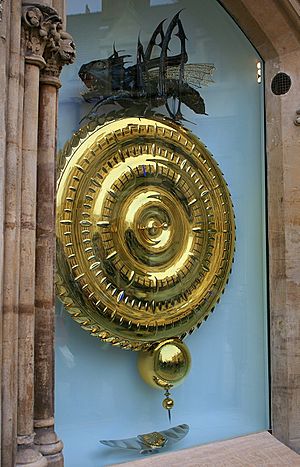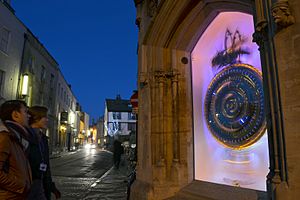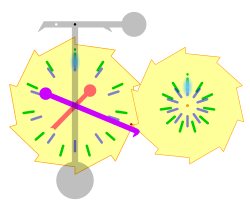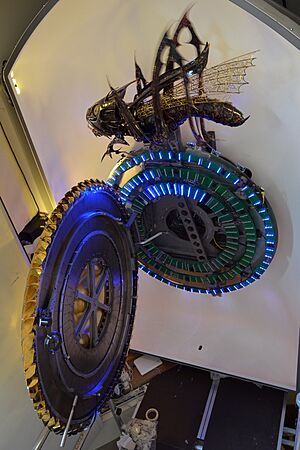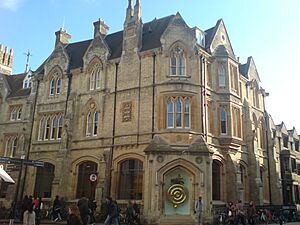Corpus Clock facts for kids
The Corpus Clock, also known as the Grasshopper Clock, is a big, cool clock you can see on the outside of the Taylor Library at Corpus Christi College in Cambridge University, United Kingdom. It's located where Bene't Street and Trumpington Street meet, looking out over King's Parade. A former student of the college, John C. Taylor, thought of the idea and paid for it.
The clock was officially shown to everyone on September 19, 2008, by the famous Cambridge physicist Stephen Hawking. Time magazine even called the clock one of the Best Inventions of 2008!
What the Clock Looks Like
The clock's face is a shiny, rippling disc made of stainless steel covered in 24-carat gold. It's about 1.5 meters (5 feet) wide. This clock doesn't have hands or numbers. Instead, it shows the time by opening small slits in the gold face. These slits are lit up with blue LED lights. They are arranged in three circles inside circles to show the hours, minutes, and seconds.
The most noticeable part of the clock is a scary-looking metal sculpture of a bug-like creature, like a grasshopper or locust. This sculpture is actually a very important part of the clock called the escapement. John C. Taylor calls this creature the Chronophage, which means "time eater" in Greek.
The Chronophage constantly moves its mouth, looking like it's "eating up" each second as it passes. Sometimes, it even "blinks" as if it's happy. The creature's constant movement makes a creepy grinding sound that fits its job. When a new hour begins, you hear the sound of a chain clanking into a small wooden box hidden at the back of the clock.
Students sometimes call the Chronophage "Rosalind" or "Hopsy."
The clock shows the exact time only once every five minutes. The rest of the time, the pendulum might seem to stop or catch, and the lights might fall behind or race ahead. Taylor says this strange movement shows that life isn't always perfect or regular.
The Chronophage was designed as a piece of public art. It dramatically reminds people that time keeps passing. Taylor purposely made it "terrifying." He said, "Time is not on your side. He'll eat up every minute of your life, and as soon as one has gone he's salivating for the next." People have called it both "hypnotically beautiful and deeply disturbing."
How the Clock Works
The Corpus Clock uses old-fashioned clockmaking methods. It has the world's biggest grasshopper escapement. This is a special part that helps the pendulum move the clock's gears smoothly, while also giving the pendulum the energy it needs to keep swinging. The grasshopper escapement was invented by a famous clockmaker from the 1700s named John Harrison. Taylor wanted the Corpus Clock to honor Harrison's work. Since most people don't know how a grasshopper escapement works, Taylor "turned the clock inside out" so that this special part would be the main feature.
The Corpus Clock's clockwork is completely controlled by mechanical parts, not by any computer programs. Electricity is only used to power a motor that winds up the clock and to light up the blue LEDs behind the slits on the clock's face. The clock has many surprising and new features. For example, the pendulum briefly stops at times that seem random, and the Chronophage moves its mouth and blinks its eyes. Taylor explained it like this:
The gold eyelids quickly move across the eye and disappear. If you're not watching closely, you might miss it! Sometimes you'll even see two blinks very quickly. The blink happens because of a hidden spring. This spring is wound up inside a part you can see on the large gearwheel at the bottom of the clock. As the huge pendulum swings the Chronophage, each back-and-forth movement helps wind up the spring. A special stop prevents the spring from winding too much, but keeps it ready to make the blink happen instantly. The blink is released at random times during the pendulum's swing. Another part chooses if it's a single or double blink, and a special air damper slows the action down to a realistic speed.
The Corpus Clock is expected to work accurately for at least 200 years.
Making the Clock
John C. Taylor spent five years and £1 million on the Corpus Clock project. About 200 people helped create it, including engineers, sculptors, scientists, jewelers, and calligraphers. The clock has six new patented inventions inside it. The rippling gold-plated dial was made using a special method called explosive forming. This involved using an explosive charge to press a thin sheet of stainless steel onto a mold underwater at a "secret military research institute in Holland." Stewart Huxley was the design engineer. Sculptor Matthew Sanderson created the Chronophage. The measuring dish for the Corpus Clock was designed by Alan Meeks of Visitech Design. It was made from aluminum and silver, then covered with gold and rhodium.
See also
 In Spanish: Reloj Corpus para niños
In Spanish: Reloj Corpus para niños


